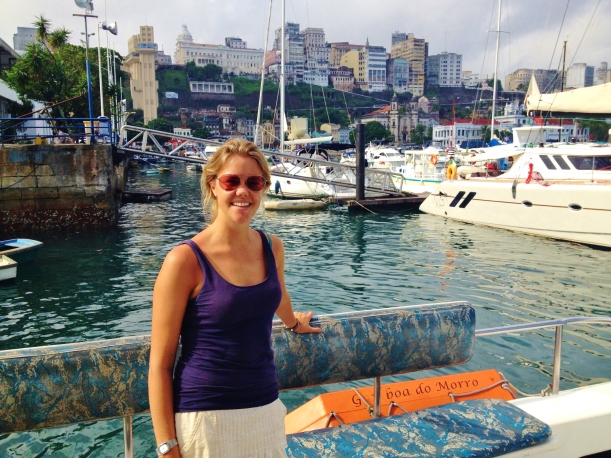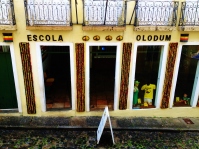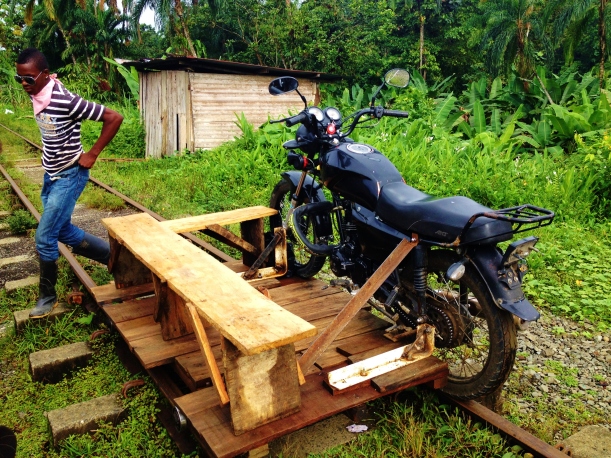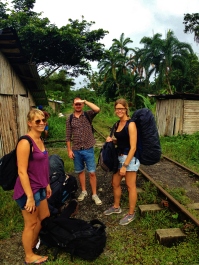
Beers with the waves lapping at your feet on 1st Beach – Morro de São Paolo
Brazil is famous for many things; football, samba and beaches are often what spring to mind for most people. Everyone can name Copacabana and Ipanema but these are certainly not all that Brazil’s massive coastline has to offer. Just a couple of hours from Salvador de Bahia, and given barely a footnote in the Lonely Planet guide, are a few small islands, the largest of which is known as Morro de São Paolo (nothing to do with and nowhere near the metropolis which shares its name). Most information we could find on it was on other blogs and these almost entirely written by Brazilians, so we decided this would be a good opportunity to sample some authentic Brazilian beach life. We were not disappointed.

Great old buildings at the port at the bottom of the Lacerda

Looking back on Salvador.


There are a couple of ways to get to the island – a cheaper but more convoluted journey by ferry, bus and small boat, or when the weather is fine and by paying out a little more (75 reais each) you can catch a catamaran directly from the port at the bottom of the Lacerda lift in the old town of Salvador. We decided to treat ourselves to this option. Having had dubious previous experiences with catamarans Rich armed himself with seasickness pills and we set off to catch the 9.30am boat. The weather was on our side and the sea was calm so while Rich succumbed to medicinal drowsiness I sat on the back of the boat and watched Salvador retreat into the distance under blue skies. Two hours later we slowly rolled up towards the island. Ancient city walls greet you just behind the port, along with a picturesque old lighthouse. Lining the jetty were rows of wheelbarrows with the word ‘TAXI’ emblazoned on the sides – this is due to the fact that the island is entirely traffic free; the wheelbarrows are run by locals offering to lug your baggage up the steep hill on arrival and around the roads and beaches to your accommodation. Given that our hostel was a mere 5 minute walk we decided to go under our own steam but fellow Brazilian holidaymakers did look at us as though we were mad! The wheelbarrow taxi ‘drivers’ all wear vests emblazoned with their names – ‘Wanderson’ being my particular favourite moniker! The few actual streets in Morro have only recently been paved – by all accounts it used to be just sandy tracks until a year or two ago and a few have complained it’s ‘not what it was’ but we can confirm that the island certainly does retain a very relaxed feel and the lack of cars is bliss!

Taxi!
Turning right off the main square we passed under a stone arch that read “Rua da Fonte Grande 1746” down to an old fountain (from around the same year) which formed the island’s water supply in years past and still flows today while doubling up as a precarious playground and climbing frame for the island’s children at dusk. Just past the fountain was our hostel; another HI-affiliated place (but much, much better than the one in Salvador) called Hostal Escorregue no Reggae. The name means ‘slide into the reggae’ in Portuguese; the colour scheme and laid-back owner back up the general theme! Recommended.

Rua da Fonte Grande 1746

Fonte Grande – Morro de São Paolo
We wasted no time in checking out the island’s beaches which are handily numbered rather than named: Primeira Praia is the first one you reach from the port, followed by Segunda Praia, Terceira, Quarta… you get the picture. As we walked onto Primeira Praia we were greeted by an Argentinian lady selling homemade empanadas which sorted out the issue of lunch pretty well and was just the first of many great beach snacks on offer. The next nice surprise was a series of makeshift bars with plastic chairs and tables selling cold beers while the sea washes over your feet. The French have the expression “pieds dans l’eau” that is used for anywhere on the seafront but this was a whole other level and probably one of the finest spots for a beer that we found; you just have to occasionally reposition your chair if a particularly large wave comes and destabilizes your drinking spot! The final surprise on this beach plummeted into view out of the corner of our eyes – a zipline that runs down from the hill on the island and deposits the user straight into the sea. It would have been easy to sit there all afternoon until the tide (or the beers) knocked us off our chairs completely but we carried on along to the other beaches; Segunda Praia is where the most action is in terms of bars/restaurants/watersports etc, and after that the beaches get quieter and a little more rugged. There’s something for every kind of beach goer really.
The next few days slid by, mainly based at Segunda Praia by day and the pizza-by-the-slice joint next to the old fountain by night. Restaurants on the island are a little pricey so we saved a few of our pennies by dining on pizza (5 nights out of 7 to be exact – don’t judge us!)
There are few great stories to tell about day after day of sunbathing but one thing worth mentioning is some of the great snacks available on the beach in Brazil. Mr Whippy and sandy sandwiches have nothing on this country’s offerings:
Fresh coconuts – drinking the water then scooping out the soft interior afterwards. Bliss.
Açai – or “assa…EEEEEEEEE” as pronounced by the lads selling it on the beach: a sorbet of dark purple açai berries topped with chopped pineapple, banana and granola (or pretty much anything you want really).
Grilled cheese – Oh yes. Sticks of halloumi-style cheese cooked right in front of you on little portable barbecues. This should be sold everywhere in the world, all the time.
Acarajé – also found in Salvador and cities but great as a sunset snack – a fried back-eyed bean fritter filled with vatapá, a kind of shrimp paste, chillies…and some other great stuff which I don’t know how to make but do know how to eat.
The other observations on Brazilian beach life are as follows:
You can wear as little as you like, but you have to wear something: In mainland Europe topless sunbathing is commonplace but in Brazil it’s not the done thing. However, wearing the smallest bikini or shorts possible is positively encouraged, whatever your age or size. It’s a refreshing attitude to be honest but you do occasionally get quite an eyeful…
Don’t even bother playing beach sports unless you’re extremely good at it: From beach football to bat and ball or ‘keepy-uppy’ volleyball – if you’re going to give it a go you have to know what you’re doing. The competitiveness and level of skill on show on a family day on the beach or a group of friends having a kickabout is extraordinary and not exactly inviting to join in, but great to watch!

These guys mean business. No 7-1 results here!
I suppose the general conclusion is…Brazilians know how to do beach life. Morro is a fantastic and authentic spot to experience it without big crowds and away from the tourist hordes (although we were slightly out of season; it could be quite a bit busier at peak time, but a visit in May is highly recommended!).
Sadly though, it was time to head back to Salvador for our final night in the Americas before our flight back to Europe. I won’t go into too much detail about our journey back to Salvador ‘the long way round’ (due to the catamaran being cancelled), suffice to say just don’t do it if you have any choice in the matter. Fork out the extra 20 reais for the catamaran if you can.

Central Square in the Pelourinho – Salvador

The excellent pully delivery system at restaurant Dona Chika-ka
By the time we arrived back in Salvador the World Cup was even closer and so the old town had been decked out in colourful flags making it an even more magical sight. The whole atmosphere of the place seemed to have revved up into celebratory mode and I found myself enjoying it more that our first visit which was a nice surprise. We had a final fantastic Bahian dinner and caipirinhas at Dona Chika-ka restaurant in the Pelorinho (the best moqueca of our time in Brazil) to the sounds of a street party down the road. It felt like a great send-off, even if it had hardly sunk in that we were leaving the continent and this leg of our adventures…



















































































